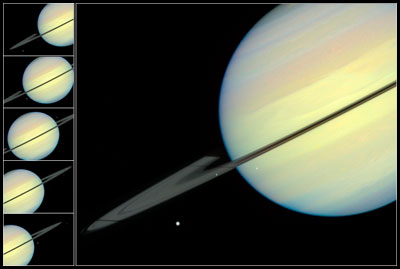01 April 2007

Credit: NASA, ESA, and E. Karkoschka (University of Arizona)
With its magnificent ring system, Saturn is a unique telescopic sight. The ringed, wonderful planet has become a star of three Hubble Space Telescope (HST) movies.
Astronomers created these movies using HST's images of the planet, acquired with sophisticated devices, the Wide Field and Planetary Camera 2 (WFPC2), and the Advanced Camera for Surveys (ACS).
Each movie highlights special orbital alignments. Like Earth, Saturn's rotational axis is tilted in space. Saturn's axial tilt is about 27°. Therefore, Saturn has seasons like ours.
Saturn orbits the Sun every 29.5 years. Our view of Saturn's rings changes as the planet orbits the Sun.
The rings are visible nearly edge-on when Saturn passes an equinox (at spring or autumn). The ringplane is at maximum tilt with respect to the line of sight when the planet is at the summer or winter solstice.
Two of the movies show the motions of several Saturnian moons, when the planet's magnificent rings were visible nearly edge-on in 1995. This alignment occurs roughly every 15 years.
The other movie shows Saturn when the ringplane was at maximum tilt with respect to Earth in 2003.
Saturn's rings can be viewed clearly with a small telescope at 20X. The PSC organizes regular public observing sessions to observe the Moon and the planets with the Center's telescopes.
Further reading
Saturn at Opposition
http://www.bibalex.org/eclipse2006/News_Details.aspx?id=201
Luxor Space Watch
http://www.bibalex.org/eclipse2006/News_Details.aspx?id=193
Hubble Website
http://hubblesite.org/
Aymen Mohamed Ibrahem
Senior Astronomy Specialist